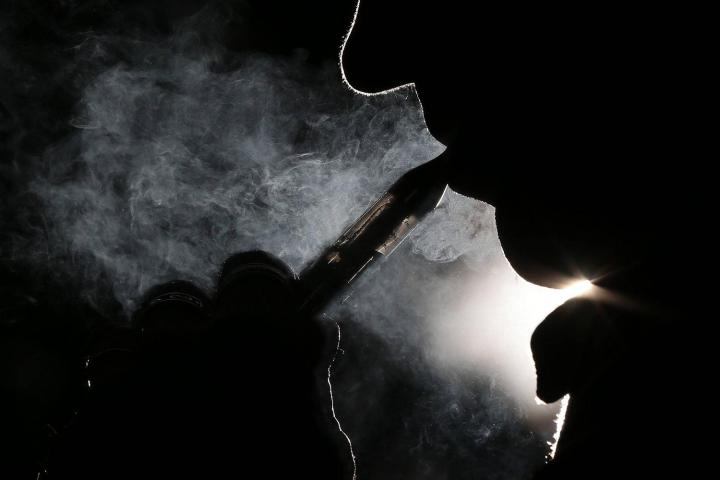
E-cigarette opponents will shoot back with a 2009 study from the U.S. Food and Drug Administration that found evidence of various carcinogens and other toxins in the vapor of two brands of e-cigarettes – findings that were supported earlier this year in a study out of France.
And those who remain on the fence will all say the same thing: We simply don’t know enough about e-cigarettes to judge their safety one way or another. As the World Health Organization wrote in July, “The potential risks [e-cigarettes] pose for the health of users remain undetermined.”
Overall lung function of those “working close to the fog source” was “significantly lower” than those not exposed to fog.
This is the narrative you’ll hear most often about e-cigarettes – that we just don’t have the science to back up safety claims one way or another. But none of the studies I’ve seen thus far – and I’ve read a whole lot of them – seem to take into consideration a potentially useful body of knowledge: Studies of fog machine “smoke.”
E-cigarettes, you see, are basically mini fog machines. Both work by heating glycols or glycerin to their boiling point, which then produces vapor. (Fog machines also use mineral oils, which are not used in e-cigarette juice.) There are a few significant differences – not the least of which is that e-cigarette juice often contains nicotine while fog machine vapor doesn’t – but the mechanics and chemicals are, at least generally, the same.
Like the safety of e-cigarettes, the health effects of fog machine vapor are matter of contention, especially among theatrical workers who spend much of their work day enveloped in fake “smoke.” However, unlike e-cigarettes, which were reportedly invented in 2003 by Chinese pharmacist Hon Lik, medical professionals have studied the health effects of fog machine vapor for decades.

The first of these studies was released in 1991 by the National Institute for Occupational Safety and Health (NIOSH), which was asked by the Actors’ Equity Association (AEA) and the League of American Theaters and Producers (now known as The Broadway League) to investigate the effects of fog machine vapor on the health of actors and theatrical workers. NIOSH followed up its study with a revision (PDF) completed in 1994. In both cases, NIOSH found that, despite a high number of theater employees reporting negative respiratory, nasal, and mucous symptoms in questionnaires, there was little objective evidence that fog machine “smoke” cause more than a bit of throat and eye irritation.
The next major study (PDF) of fog machine “smoke” came in 2001 from the Department of Community and Preventative Medicine at the Mount Sinai School of Medicine and ENVIRONS, an environmental consulting firm. Like the NIOSH studies, the 2001 study was also commissioned by the AEA and the League of American Theaters and Producers. Also like the NIOSH studies, researchers found that inhaling vaporized glycols – like propylene glycol, a primary ingredient in e-cigarette juice – can cause “respiratory irritation, shortness of breath, and coughing.” Due to this, the study made a variety of detailed recommendations for how to monitor the amount of fog machine vapor in a particular space, and prescribed maximum exposure limits.
The primary question remains: If these are the short-term symptoms, what are the long-term consequences?
Perhaps the most recent study investigating the effects of fog machine vapor came in 2005. Conducted by the School of Environment and Health at the University of British Columbia and published by the American Journal of Industrial Medicine, this study focused on theater and other entertainment workers who were exposed to fog machine “smoke.” Unfortunately for the e-cigarette crowd, “acute cough and dry throat” resulted from high exposure to glycol-based vapor, and the overall lung function of those “working close to the fog source” was “significantly lower” than those not exposed to the fog.
As mentioned above, the correlation between the effects of fog machine vapor and e-cigarette vapor is far from perfect. Puffing on an e-cig is going to expose you to quite a bit more vapor than just being in a room with a fog machine running. On the flip side, fog machine smoke often uses chemicals that aren’t approved for human consumption, while e-cigarette liquid is often made of food-grade propylene glycol and vegetable glycerin.
What we can take from these studies, however, is that e-cigarettes will likely not be consequence-free. Coughing, dry throat, headaches, dizziness – all of these symptoms have been found among those exposed to high amounts of fog machine vapor, and e-cigarette users will privately report similar danger signs. (For the record, I’m one of them.) Still, fog machines haven’t been banned – a move some regulators would like to take with e-cigs.
At the end of the day, the primary question remains: If these are the short-term symptoms, what are the long-term consequences? That, unfortunately, remains to be seen, heard, or felt.
Editors' Recommendations
- FTC hits Juul, Altria with antitrust lawsuit over $12.8 billion deal
- New lawsuit accuses Juul of targeting kids on Nick Jr. and Cartoon Network sites
- ‘We can’t say what’s safe’: Doctors react to Trump abandoning vape ban
- Juul discontinues sales of its mint-flavored pods
- Black market THC vape pods have killed dozens. Why are people still buying them?


